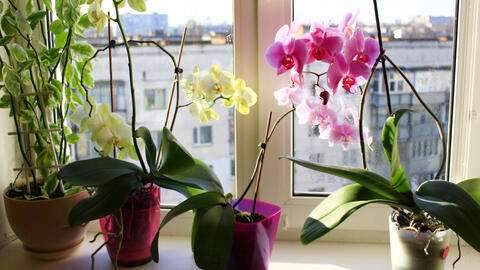Orchids: The Most Common Diseases and Pests
Weak or already damaged Orchids often have to fight against diseases and pests. Here we provide information on the most common plant protection problems for Orchids and how to detect pests in time.

Even small mistakes can lead to diseases and pests when caring for Orchids
As with all plants: caring for your Orchid well is the best form of prevention. But despite an optimal supply of nutrients, water and light, plant diseases and pests can still affect your Orchids. In the following sections, we’ll introduce you to the most common ones and explain what you can do about them.
The Mosaic virus appears on the underside of older leaves as mosaic-like black spots, which spread onto the upper surface of the leaves as the disease progresses. The stems of the Orchid then rot from the inside out. If you discover an infestation, you should immediately dispose of the affected plants in your household waste, because, unfortunately, there is no successful treatment for this viral disease. To prevent undetected infections from being transmitted to other Orchids, you should thoroughly clean shears and cutters before and after each use.
The fungi Phytophthora and Pythium are responsible for Black rot – also known as stem rot or black vein. Affected Orchids turn yellow and then black, before eventually dying. The species Vanda and Phalaenopsis lose their leaves very quickly. Diseased plants, infected pots and contaminated substrates can cause fungi to spread rapidly. You should therefore regularly check these for any abnormalities. Cool and wet conditions also promote fungal growth. Both root infections are also incurable – so it is better to part with infected plants sooner rather than later. However, these infections do not spread to healthy specimens as easily as viruses, which are often transmitted by sucking pests, such as spider mites.
Grey leaf spot diseases occasionally occur on Orchids, too. They are caused by fungi of the genera Colletotrichum and Cercospora. The fungi cause yellowish, brown, black or reddish leaf spots, often with a dark edge. Since these are secondary parasites, the best way to prevent them is to find a suitable location for your Orchids and to look after them correctly. You can usually save infected plants by removing the affected leaves. Then put the Orchids on the patio and treat with a suitable fungicide.
Easily mistaken: Burns caused by extremely sunny locations, incorrectly used fertilizers and nutrient deficiencies can also cause yellowish and dark leaf spots to appear. First check whether the leaf spots might have been caused by something other than a parasite.
One of the most common pests to affect Orchids are spider mites. These insects are most often found on the underside of the leaves of affected plants. One sign of spider mites on orchids are brightly speckled leaves, which become brown and dry as the infestation progresses.

The insects inject toxins while sucking on the leaves. This has a severe impact on the plant’s growth. Viruses, bacteria and fungi can easily penetrate these punctures. You should remove all affected leaves. Predatory mites have also proved useful in fighting spider mites. Commercial organic products based on potassium soap or canola oil are also good for combating spider mites. However, you should first test the remedy on one leaf, because not all varieties of Orchids can tolerate the treatment.
Since scale insects are usually introduced by newly purchased Orchids, you should take a close look at the desired plants already in the nursery. The pests are mainly found on the underside of Orchid leaves, where they match the color of their surroundings. The small scale insects feed on the sap of the Orchids with the help of their sucking trunk. As a result, the leaves of the plant start to appear deformed and droopy. By sucking on the plant, they also create small holes, which are ideal entry points for fungi and viruses, such as the mosaic virus. The insects also make the leaves sticky by secreting a sugary liquid, known as honeydew, on which a black mold often forms.
To prevent it spreading to other plants, the first step should be to put the infested Orchids into isolation. Once you’ve done this, the most effective solution is to scrape off the scale insects using a blade and then collect it. As scale insects tend to hide between the bracts of Orchids, removing these is recommended.
Tea tree oil is an effective organic control measure. It is best to dab the oil onto the affected parts of the plant using a cotton swabs. The oil deprives the pests of air and they die. A word of caution: the repeated use of products like these can cause the sensitive plant to lose its leaves.

Thrips are other sucking insects that can damage Orchids. They puncture the surface layer of the plant tissue, filling the cells with air. These then reflect the light like little mirrors. This causes a characteristic silver shine on the affected parts of the plant. Black fecal remains also indicate an infestation with thrips. As with spider mites, you can use an organic treatment containing potassium soap or canola oil.



